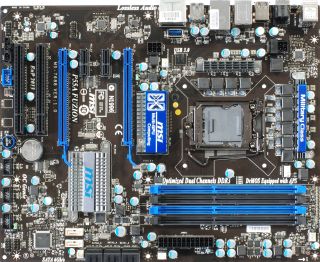Time To Upgrade: Should You Dump Your 2007 PC?
Intel agressively promotes its Core i3/i5/i7 series, but we wonder: Does it make sense to replace a three-year old high-end PC? In the end, quad-core processors were already pretty powerful in 2007. We created a brand new system and a 2007 PC to compare.
The 2010 System: Intel P55 Express
One of the latest motherboards we've received for the LGA 1156 interface is MSI’s P55A Fuzion. This is an upper-mainstream motherboard that compares well to the P35 Platinum from a positioning and price standpoint. The large motherboard vendors started an arms race (from a feature and quality standpoint) a few years ago, and hence this motherboard is no exception. MSI implemented a 10-phase switching voltage regulator, together with most of the key features you might remember from the BigBang Xpower flagship, including two SATA 6Gb/s ports and two USB 3.0 ports through additional controller chips. One of the USB 3.0 ports is placed directly on the motherboard to possibly route to a front-panel connector.

The board comes with two fully-featured PCI Express 2.0 slots that are both powered by 16 PCIe 2.0 lanes. This is made possible by utilizing a PCI Express switch chip, the Lucid LT22102. It multiplexes the Core i7's 16 available lanes to a pair of x16 slots running electrically at x16 signaling rates. As we saw in the article USB 3.0, SATA 6Gb/s, Motherboards, And Overcoming Bottlenecks, this is helpful to maximize dual graphics performance, while still maintaining maximum bandwidth for SATA 6Gb/s and USB 3.0 devices.
On the subject of dual graphics, the switching solution enables AMD CrossFire and Nvidia SLI operation, as well as mixed dual graphics modes. The mixed mode also extends to setups from the same vendor. While SLI requires cards with the same GPU type, this motherboard can combine any Nvidia GPU between the GeForce 9000- and GTX 400-series. The same applies to ATI, where you can use Radeon HD 4000 or 5000. We’ll be looking at this in a dedicated review, as this might also open a nice upgrade path if Lucid has fixed the compatibility and performance of its driver.
What Does Such a New Platform Do For Me?
Overall, the 2010 platform based on the Intel P55 chipset offers increased flexibility compared to the 2007 configuration. Overclocking has improved and, more importantly, has become much easier thanks to value-added features. Multi-GPU capabilities are impressive, but still subject to some benchmarking. And, finally, power consumption, efficiency and interfaces like USB 3.0 and SATA 6Gb/s remove remaining bottlenecks. But it this enough to justify buying a new system if you went for a high-end machine in 2007?

Stay on the Cutting Edge
Join the experts who read Tom's Hardware for the inside track on enthusiast PC tech news — and have for over 25 years. We'll send breaking news and in-depth reviews of CPUs, GPUs, AI, maker hardware and more straight to your inbox.
Current page: The 2010 System: Intel P55 Express
Prev Page 2007 Components: Core 2 QX6700, GeForce 8800GTS, WD Raptor Next Page 2010 Components: Core i7-870, Radeon HD 5870, G.Skill Phoenix SSDMost Popular

